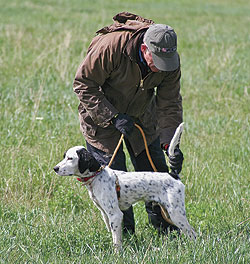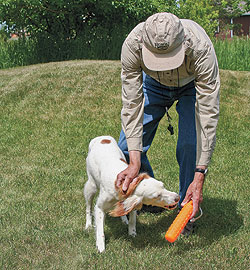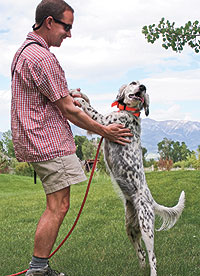Sometimes, effective training will rub your dog the wrong way.
By Dave Carty
 To lessen stress on the dog, make your commands clear and your corrections brief and non-emotional. |
About the time I was dragged, kicking and screaming, into my junior high math class was about the time I discovered I couldn't do story problems. It was an intensely frustrating experience. In those simpler times, it was considered expedient to make examples of slow learners, and I was continually called upon by a series of teachers to demonstrate my ignorance before my classmates.
This happened too often to be chance; we both knew I didn't know the answer. But before the end of the day, there was sure to be relief for my distress: physical education class. P.E. was something I enjoyed, something I was good at, and an escape from the academics I loathed.
And so it is that the overall level of happiness in a dog undergoing intensive, daily training is far more important than the occasional bouts of frustration and confusion he experiences. Yet I'm continually being asked by folks what they should "do" about a dog's drooping tail, his cowering, and so on.
Their hearts are in the right places, and they're paying attention to their dog, which is all to the good -- in fact, it's the mark of a good trainer. But, I try to suggest diplomatically, they may be reading a bit too much into their animal's temporary discomfort. Dogs are like people: they fear what they don't understand. And if a dog doesn't understand the command you're teaching him, he's not going to be a happy camper.
Don't get me wrong -- there's real value in trying to eliminate as much stress from training as possible, but some of these folks confuse the big picture with the small. An animal that has something to look forward to can easily withstand an occasional bout of confusion during a training session, just like I was able to weather my junior high math class knowing my reprieve would come in the form of an afternoon of dodge ball or gymnastics.
While temporary unhappiness on the dog's part isn't a problem, a depressed dog is. A dog that isn't happy to see you in the morning is a dog that, barring any physical problems, is probably being forced to do too much too fast. It's also important to remember that canine personalities vary as much as human personalities do, and that some dogs are simply softer, more somber, and more easily upset. But all of them, if you treat them fairly, will quickly forgive you the temporary discomfort you're causing them and get on with their lives.
My way of dealing with a dog's stress is straight forward: I give him treats, birds, and affection. In the retriever world, trainers often end sessions by giving their dogs a fun bumper -- a bumper thrown with no strings attached. In the pointing dog world, I give my dogs birds.
There's nothing I can think of as stressful as force breaking. That works both ways, by the way. Of all the things I do with dogs, the initial stages of force breaking are really about the only training I don't enjoy. But it's important; I recommend it to everyone who brings me a dog to train; so I've tried, over the years, to make it as easy on my canine students as I can.
 Force breaking is a stressful situation for any dog. You can boost a dog's spirit by following a training session with a few minutes of letting your dog find and point planted birds. |
Like most people, I start my dogs on a bench, but rather than jump immediately into an ear pinch, I first let the dog get used to the idea of holding a wooden dowel in his mouth.
To do this, I wedge my thumb into the back of the dog's mouth, insert the dowel, and gently hold it in place, repeating the command "hold" or "fetch" over and over. Once the dog has accepted the dowel, something most do in a few days, I release my grip on his muzzle and stroke him, continuing to repeat the command. It is only then, after several days of gentle reassurance, that I introduce the ear pinch.
Does this method lessen their stress? I can't prove it but I believe it does. But in no way does it lessen their dislike of an ear pinch; I expect a fight as soon as it's introduced and I'm rarely disappointed. Some dogs accept the ear pinch in a few days and begin reaching for the dowel; others take weeks of stubborn persuasion. None of the dogs I've trained look forward to this; and it's not unusual for them to hide in a corner of the kennel when they know a force breaking session is imminent. Who wouldn't? This isn't fun for either one of us.
Without something to bring the dog's spirits back up, force breaking, which can run for six weeks to two months or longer, runs a real risk of killing a dog's enthusiasm. But there's a simple antidote for the canine blues: birds.
I start off every dog I'm training with extensive exposure to planted pigeons. By the time a trainee is ready for force breaking, he's been through months of exposure to pigeons on whoa training, steadiness training, and so on. Birds are something he knows and loves, and giving him a bird to point at the end of a tough session of force breaking brings his tail up, perks his ears, and gives him something to look forward to.
The thing you have to remember about training, because your dog can't, is that training sessions eventually end. Most dogs are far more confused and frustrated by corrections, electronic or otherwise, than they are physically hurt by them. True, a painful correction will make a dog slink away from the task at hand and tuck his tail between his legs€¦but so will confusion. So a basic rule of thumb to lessen the confusion inherent in any form of training is to make your commands simple, direct and repetitive.
Use single-word commands and make corrections quick and non-emotional. And -- I can't stress this enough -- take your time. You can't spend too much time teaching any command, but you can easily spend too little. What's the hurry? When the dog finally gets it -- and he will -- I'll bet a bottle of my favorite single malt you'll see an amazing transformation. His tail will come up, there may even be a spring in his step, and he'll be happy once again. Now he understands what it is you want. His confusion is gone.
 Affection and treats are always appropriate if the d og has earned them. |
Although birds are my ace in the hole, I use treats and praise throughout the training process. Like a lot of people, I used to believe that treats were fine for puppies, but had no place in training adult dogs. Treats, the theory went, would make an adult dog more interested in food than in pleasing you.
But over the years, nothing remotely like that ever happened. Today, I use treats with dogs of any age, and throughout my five-month summer training sessions. Not all dogs respond to them. This summer, I'm training a little tri-colored setter named June, a pistol of a bird dog who lives for birds. Only after a training session is over will she accept a treat. That's fine; a dog biscuit or two is her reward for a job well done.
The other dog in my kennel this year is a pint-size Brittany, Annie, and like most Brittanys, she never saw a treat she didn't like. But that's fine too -- treats buck up her spirits just as much as they do June's. If either dog is facing a tough day, they may well get a treat before they begin their training session and a treat after it's over, something they can look forward to.
Finally, there's praise. We all know that it's important to praise a dog for a job well done, but during the heat of a training session, praising a dog who doesn't earn it will only confuse him further.
Here's how it looks from the dog's point of view. You've just told him to kennel, a word he doesn't quite understand. So he prances around his crate, confused, and finally pokes his nose in the door. Misinterpreting his confusion as effort, you praise him. But now the dog is doubly confused. He likes the praise, but what did he do that prompted it? Was it running around his crate? Sticking his nose in the door? He doesn't know.
Instead, make it easy on him. Tell him "kennel," push him inside his crate, and then, when he's completely inside, praise him. Better yet, praise him and give him a treat. Only later, when you're sure he understands what it is you want, should you correct him if he disobeys.
But again, make your corrections brief and non emotional. Dogs pick up on negative emotions instantly; set them aside while you're training and it will be one less thing your pup has to filter out en route to understanding. When the dog finally gets it -- that "aha!" moment -- watch closely and you may see him smile. His confusion is gone, and he's happy because he's in control again.
I never got there with story problems. But I wonder sometimes, knowing what I know now, how well I'd do today?






